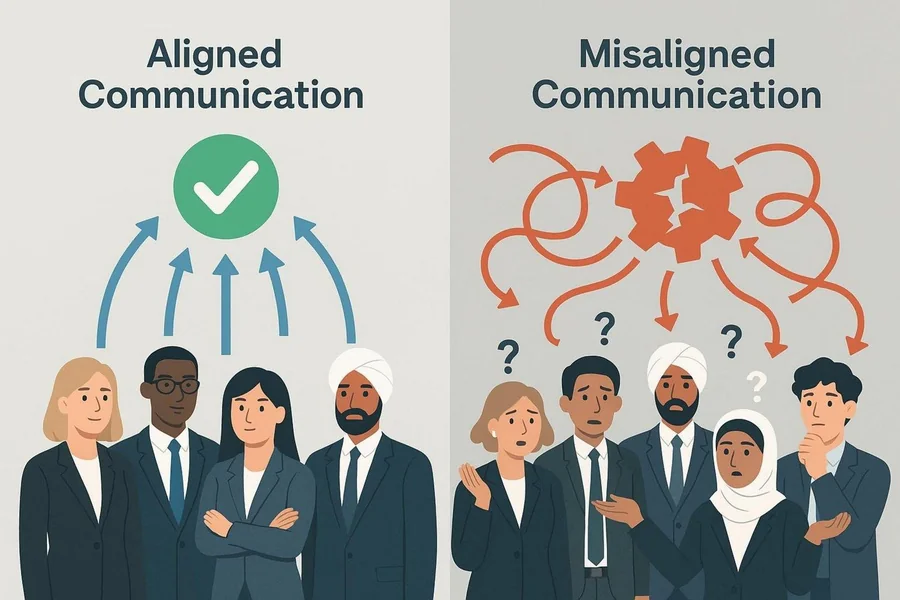Today, a communication plan only helps if it clearly supports your business goals. How do you make sure your messages don’t fade into the background but actually move the company forward? Do it by aligning them with what the business is trying to achieve. That means planning and sharing messages, inside and outside the company, that back clear outcomes.
Whether you’re launching a product, entering a new market, or improving employee engagement, good communication acts like the engine that keeps everything moving in the right direction. For example, using channels like social media campaigns can build a strong, memorable brand image and directly support growth plans.
Without this alignment, even well-meant messages can miss the mark. Teams get out of sync, efforts drift apart, and money gets wasted. Imagine marketing pushing one story while internal comms accidentally undercuts it.
Strategic communication is more than sending information. It shapes how people think, guides behavior, and leads to real results. It turns talking into real connection, where each message has a clear job and points the company toward success.
What Is Strategic Communication Alignment?
Strategic communication alignment is the planned use of communication to meet specific business goals by guiding how audiences think and act. It brings together public relations, marketing, and internal comms to deliver clear, consistent messages that work well together.
This is an ongoing cycle of planning, doing, and checking results so messages reach the right people and make sense to them.
The main idea is that every message-whether it’s an internal memo or a press release-should support the company’s top priorities. This connection helps leaders make better choices, build a stronger brand, tackle problems early, and grab new chances in a fast-moving communication space. Communication becomes a core part of the business plan, not an afterthought.
How Communication Strategy Connects to Business Goals
Communication and business goals feed into each other. A clear communication plan shows how to share key messages with each audience, so work stays aligned and effective. If a goal is to cut employee turnover, internal comms might spotlight recognition programs, career growth paths, and work-life balance.
When messages keep pointing back to these aims, employees see purpose in their work and how they fit into the bigger story.
This link means communication is about more than sending updates. It shapes perception, builds engagement, and supports business targets with focused, useful messages. It turns scattered efforts into coordinated action. When comms match company goals, your message feels united and strong, and campaigns deliver better results.
Common Misconceptions About Alignment
A common myth is that alignment is only the job of the comms team. In truth, it needs support from leaders and teams across the business. Another mistake is treating communication as something you do only during a crisis or big launch. It should be steady and forward-looking, offering direction and reinforcing core messages over time.
Some think alignment means saying the exact same thing to everyone. That’s wrong. Good alignment adapts messages to each audience while keeping a shared core. Without this, people tune out or miss key updates. The goal is not just to speak, but to speak in a way that matters to each group-and leads to action.
Why Align Your Communication Strategy With Business Goals?
Aligning communication with business goals is a must for lasting success. When messages tie directly to what the company plans to achieve, work becomes more focused, culture feels more connected, and relationships with stakeholders grow. Each message-inside and outside the company-adds to the mission instead of working alone.
This approach gives employees clarity and confidence, builds trust, and helps the company adjust to a market that keeps changing. It turns communication from a support role into a driver of growth that affects revenue, costs, and long-term health.
Key Benefits of Aligning Communication and Business Objectives
- Clarity and purpose: People see how daily tasks link to business success. When goals flow from leaders to teams in plain language, decisions get easier and faster. Companies with connected employees often see a 20-25% productivity lift.
- Fewer silos: Teams work together more, sharing ownership of results. HR, IT, finance, and operations pull in the same direction. Inside and outside messages line up, so the brand feels steady and reliable.
- Better results: Engagement rises, brand reputation grows, and the company competes more effectively because words and actions match.
Risks of Misaligned Communication
When communication drifts away from business goals, problems pile up. Money and time get wasted, and the workforce splinters. Employees may not see how their role fits the plan, so they lose energy and focus. Teams can chase different goals that clash, leading to missed chances and high costs.
Leaders may find that messages about strategy never reach beyond upper management. Poor communication is expensive-high-earning employees can lose 46 workdays a year dealing with it. That hurts productivity, adds stress, and raises the odds of missed targets and failed projects.
Without a clear plan tied to business aims, messages confuse, trust slips, and the mission suffers.
Improves Company Culture and Employee Engagement
When communication lines up with company goals, culture gets stronger and people engage more. Employees want to feel connected, and steady leadership messages plus a strong plan help make that happen. When everyone sees how their work supports the strategy, teams work together better and feel part of shared wins.
This clarity lifts performance. Good internal comms push more people to engage at work. The impact shows up in higher productivity, better wellbeing, and stronger diversity, equity, and inclusion.
When people absorb company values through clear messages, they carry those values into daily actions-leading to better customer experiences. A healthy, aligned culture also helps hire and keep great talent, creating a positive cycle of growth.
Strengthens Stakeholder Trust and Brand Reputation
Alignment plays a key role in building trust and improving brand reputation. When messages are open, believable, and steady-and match what stakeholders expect-trust grows. This trust supports stronger relationships, adds credibility, and lifts the success of communication efforts over time.
Outside the company, alignment helps shape how people see the brand and builds loyalty. It keeps messages consistent so the public story matches the internal one. By facing risks early and holding a positive, true picture of the brand, communication helps build a durable reputation.
A clear story and smart channels help a company stand out and connect more deeply with its audience.
Essential Elements of an Aligned Communication Strategy
Building an aligned communication strategy is a carefully planned effort based on a few core parts. These parts create a strong framework so every message has a purpose. You need clear goals, real audience insight, and the right mix of channels to turn big business aims into daily communication work.
Without these building blocks, messages can feel messy and unclear. The goal is a single, joined-up approach where all communication pushes in the same direction.
Defining Clear, Measurable Business Goals
The base of alignment is clear, measurable goals. Vague wishes don’t help. Set three to five measurable company goals that connect to your main strategy. Make them specific enough to guide action but wide enough to fit different teams. Each one should tie to the mission and show how you will track success.
Good goals guide planning, set performance markers, and build shared understanding. Frameworks like OKRs (Objectives and Key Results) work well here. When people know the top priorities, they can spend time on what matters most and drive real results.
Translating Business Objectives Into Communication Priorities
After setting business goals, turn them into clear communication priorities. Decide how communication will support each goal. If you aim to grow in a new market, priorities may include educating employees about the market, running targeted external campaigns to build awareness, and keeping messages steady across every touchpoint in that region.
With a solid view of company priorities-like a merger, lowering turnover, or launching new products-internal comms can shape messages and campaigns that echo these aims. When messages keep linking back to top goals, people see how their work matters and feel part of the bigger plan.
Stakeholder and Audience Identification
Effective communication starts with knowing your audiences. One message for everyone rarely works. Map stakeholders-investors, employees, customers, media, and even competitors-and group them by needs, interests, and how they like to get information.
Inside the company, teams are often diverse, multigenerational, global, and spread across time zones. Office workers may respond well to email and internal platforms, while frontline teams may need mobile-first tools. By spotting these differences, you can write messages that speak to each group and raise impact. That reduces overload and builds stronger engagement.
Choosing the Right Channels and Tools
Picking the right channels and tools is very important for aligned communication. A single channel rarely reaches everyone. Choose based on audience preferences, urgency, and content type. Email and intranets may suit office workers, while deskless or remote employees may need mobile apps, digital signage, or integrated platforms.
Outside the company, using interactive content or social media campaigns can help shape a clear, memorable brand.
Inside, tools like enterprise email platforms with analytics and multi-channel publishing help get timely, relevant updates to people in the way they prefer.
| Audience | Best-fit channels | Typical content |
| Corporate/office staff | Email, intranet, chat, webinars | Strategy updates, policy changes, training |
| Frontline/deskless | Mobile app, SMS, digital signage | Safety notices, shift info, quick tips |
| External audiences | Website, PR, events, social media | Brand stories, launches, thought leadership |
Make information easy to find without adding clutter. The aim is that messages are received, understood, and acted on, so they support business results.
Consistency in Messaging Across Internal and External Audiences
Keeping messages steady inside and outside the company is a must. People should not hear one thing internally and see another publicly. A single voice backs company goals and builds trust.
Keep tone, messages, and branding steady across channels, building a clear identity. This does not mean repeating the same words, but keeping a shared story and values. Inside comms should match the public brand story, so employees hear the same themes that customers do. This steady voice boosts teamwork inside and loyalty outside.
Steps To Align Communication Strategy With Business Goals
Alignment comes from a clear process, not a one-off move. Start with a review, then build, launch, and improve. Each step builds on the last so communication is focused, on target, and able to drive results. This turns comms from a task list into a core part of strategy.
Follow these steps to build a framework that responds quickly, adjusts to change, and keeps strategic priorities front and center at every level.
Step 1: Assess Current Business Objectives
Begin by reviewing current business goals. You need a clear picture of what leaders want to achieve in the next months and years. Are they planning a new product, a new market, or a new model? These priorities can shift with global events, new tech, and customer behavior, and they guide all communication work.
Internal comms should stay close to leadership plans. Ask questions, listen closely, and confirm what you heard so there’s no confusion. Once key goals-like cutting turnover, managing a merger, or launching products-are clear, you can build a support plan that fits. Without this clarity, messages will drift.
Step 2: Audit Existing Communications
With goals in hand, run a thorough audit of current comms. Look at what you’re doing now and why. Check if each tactic supports the mission and moves the company closer to its goals. Use this chance to “clean house,” removing what doesn’t work and focusing on channels that do.
This review will show strengths and gaps and give data you can use to set comms goals. Map key channels, check how well employees know company aims, and gauge how they feel about frequency and leadership messages. Use what you learn to refine channels and formats for bigger impact.
Step 3: Develop Messaging That Supports Strategic Priorities
Next, build messages that directly support business goals. Skip vague announcements. Write clear, useful, and steady messages that speak to each audience and guide the actions you want. Every message should back the company plan and show how individual work connects to the vision.
If a main goal is a product launch, focus on teaching employees about features and benefits, building cross-team work, and earning buy-in. Turn high-level plans into simple, memorable themes that guide daily decisions. The aim is that every message-inside and outside-has a job and helps hit the goal.
Step 4: Engage Employees in Goal Alignment
Bring employees into the process so strategy feels shared, not distant. Leaders must understand the goals, but every person should see how their role helps. Involve people early by gathering input on priorities, testing messages with focus groups, and inviting teams into goal-setting where possible.
Real participation builds ownership and better insights. People on the front lines can flag what will work and what needs adjustment. This teamwork creates realistic targets and performance expectations and builds deep commitment to success.
Step 5: Implement Targeted Communication Initiatives
Now put the plan into action. Share the right messages through the right channels for each audience. Go beyond one-off notes. Make sure every employee-no matter their role or location-gets timely, relevant information.
Start with company-wide sessions like town halls, then follow with detailed materials. Build messages into the everyday employee journey so updates feel natural, not random. Give managers clear guides and tools to translate strategy for their teams; they are a key link between leaders and employees. Use multiple channels and adapt messages by role and behavior so they reach all levels and drive action.
Step 6: Monitor, Measure, and Adapt Your Approach
Keep checking how the plan is working and adjust often. A strategy is a living document. Track progress against your internal comms goals and see how messages perform over time. Watch metrics like open rates, clicks, survey responses, and satisfaction scores to learn what lands and what doesn’t.
Collect data regularly, spot patterns, and test changes. This keeps improvement steady and lets you refine your methods. Maintain a constant feedback loop and stay ready to adjust to changing conditions, industry shifts, or unexpected events. That way, your plan stays flexible and effective.
How to Measure the Impact of Strategic Communication Alignment
Measuring impact is important to prove value and keep efforts on track. Numbers beat opinions when showing the return on communication. Pick the right metrics, set SMART goals, and use steady feedback to track progress and make good changes.
Without strong measurement, comms can look like a cost center. With solid results, comms leaders gain a stronger voice at the table and can show how their work supports revenue and savings.
Key Metrics for Communication Effectiveness
Track a mix of metrics to see how your plan performs. For internal comms, watch email read rates, opens, and clicks to see reach and engagement. Use surveys or polls to check understanding and sentiment.
Add qualitative inputs like comments from focus groups or analysis of employee feedback to learn how people feel and what they took from messages. For alignment more broadly, look at productivity, retention, project speed, decision quality, and team morale. Tie your metrics to what leaders care about most-growth and cost control-so the link to business goals is clear.
Examples of SMART Goals for Communication Teams
SMART goals-Specific, Measurable, Achievable, Relevant, and Time-bound-remove guesswork and set a clear path. Examples include:
- Specific: Increase employee engagement with internal newsletters.
- Measurable: Increase employee newsletter open rates by 15% within 3 months.
- Achievable: Improve employee understanding of company values by 20% as measured by a post-communication survey conducted within the next year.
- Relevant: Reduce time spent searching for company information by 10% through a revamped internal knowledge base by the end of the next quarter.
- Time-bound: Increase employee participation in company-wide virtual town halls from the current average of 60% to 80% within the next six months by sending personalized reminders.
These goals make the target clear, show how success will be tracked, and set realistic timing so efforts stay focused and useful.
Continuous Feedback and Performance Check-Ins
Ongoing feedback and regular check-ins help keep alignment strong. Goal alignment is not a one-time job. Build updates and feedback into channels you already use-newsletters, team meetings, recognition programs. Use one-on-ones to talk about progress and spot obstacles early.
Performance tools should connect individual goals to company goals and include regular reviews. This steady conversation keeps people on track and offers chances to adjust and support. Ask for input from employees, customers, and stakeholders, then act on it. This approach builds trust and keeps alignment alive as needs change.
Best Practices for Sustaining Alignment
Keeping alignment strong takes ongoing effort. It works best when strategy and communication become part of daily habits and culture. With a set of best practices, companies can keep messages relevant, people-focused, and tied to changing goals. These practices focus on being active, connected, and people-first.
From leaders to individual contributors, these habits build shared understanding and commitment, turning alignment into a normal way of working.
Cascading Goals From Leadership to Teams
Share goals from the top down in a clear, repeatable way. Start with a company-wide town hall where leaders explain the strategy and goals, answer questions, and help people connect to the vision.
Then send detailed follow-up materials-visuals, summaries, and short videos. Managers play a key role by turning the big picture into team and individual goals during one-on-ones and team meetings. This flow keeps the message intact while letting each role apply it in practical ways.
Integrating Communication in the Employee Journey
Weave communication throughout the employee journey, from onboarding to growth and even offboarding. Treat it as a continuous, personal experience, not a set of random announcements. Use every touchpoint to reinforce values, priorities, and how each person contributes.
Deliver timely, relevant information that helps people do their jobs better. Content templates can guide timing and flow, keeping messages steady while allowing personalization by role, location, and needs. This approach deepens engagement and turns employees into active partners in meeting goals.
Personalizing Messaging by Audience Segment
Personalize messages so they stand out in a busy day. One-size-fits-all rarely works. Segment by role, department, location, and interests. Keep the core message steady, but adapt details to each group.
For example, frontline teams may need short, actionable updates on mobile, while corporate teams may want deeper context on internal platforms. AI and data can help deliver the right information, via the right channel, at the right time, with the right context. This turns generic messages into targeted ones that drive action.
Leveraging Omni-Channel Communication Strategies
Use an omni-channel approach to reach everyone. Modern workforces are diverse and spread out, so one channel isn’t enough. Combine channels and plan delivery so key information reaches all employees.
Deskless and remote teams may not check email often. Use digital signage, mobile apps, integrated platforms, and even podcasts with executives. Offer multiple touchpoints to avoid silos and invite everyone into alignment efforts. A joined-up approach raises the odds that people receive, understand, and act on strategic messages.
Recognizing and Rewarding Aligned Behaviors
Shine a light on behaviors that support strategy. Don’t stop at stating goals-celebrate real examples of people and teams who put them into action. Stories make goals relatable and show others what good looks like.
Public recognition helps spread the right habits and shows how wins connect to business goals. Rewards should highlight both the result and how it supports the strategy. Regular recognition builds a culture where alignment is seen, valued, and repeated.
Common Challenges and How to Overcome Them
Even with the best intentions and careful planning, hurdles will appear. These can slow the flow of information, weaken messages, and hold back progress. Spotting and addressing these issues early is important to keep a strong, flexible plan.
Getting past these challenges takes flexibility, steady effort, and a focus on improvement so communication stays a driver, not a blocker.
Adapting To Organizational Change
Change is constant-market shifts, new tech, and restructuring all affect communication. To keep pace, comms teams need to adjust messages and methods as things change. Stay alert to audience preferences, new tools, and outside forces that can reset priorities.
Communication plays an important role in explaining the why, the benefits, and the details of change. To carry change forward, you need timely, open, and empathetic messages that build understanding and support. With adaptable communication, leaders can face challenges early, act on new openings, and stay relevant in a landscape that keeps changing.
Bridging Cross-Functional Communication Gaps
Department silos are a common barrier to alignment. When HR, IT, finance, operations, and others work in isolation, messages conflict and the strategy loses strength.
Comms teams should build close partnerships across functions. Align plans with peer teams so messages support a single direction. Encourage shared ownership and open dialogue. This breaks barriers, strengthens decision-making, and helps everyone execute the business plan together.
Frequently Asked Questions
What types of business goals benefit most from communication alignment?
Most goals gain a lot from alignment, but some stand out. Growth goals-like entering new markets or launching products-need communication to inform, excite, and mobilize teams and customers. Goals about culture, engagement, and retention also win big because clear messages build connection and purpose.
Also, big shifts-like a merger or a new business model-need steady, consistent communication to manage change, reduce uncertainty, and make the move smoother. Any goal that needs cross-team effort or aims to shape how people think and act-employees, customers, or investors-will benefit from an aligned plan.
How often should you revisit your communication strategy?
A communication strategy should evolve. Do a full review at least once a year, ideally in step with business planning cycles. In fast-changing times, check in more often.
Priorities can change quickly due to world events, new tech, or customer shifts, which means your approach may need updates. A quarterly or monthly look at key metrics and feedback is a good idea. This steady tracking supports quick, data-led tweaks so your strategy stays flexible, responsive, and aligned with what the business needs now.






